April 28, 2017
The C form-factor pluggable (CFP) is specified by a multi-source agreement (MSA) among many manufacturers for the transmission of high-speed digital signals. The CFP transceiver can both support 100 Gbit/s or OTU4, and 40Gbit/s OTU3 signals. The 40G and 100G CFP transceivers are hot-swappable input/output devices that can be plugged into the 40-Gigabit and 100-Gigabit Ethernet module ports. CFP-40G-LR4 has the same footprint as CFP-100G-LR4, and both of them terminate with duplex SC fiber connectors. Except that they support different transmission distance, what are the detailed information about them?
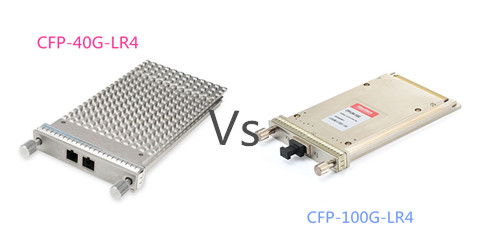
40G CFP-40G-LR4
The Cisco CFP form factor can also operate over 40GbE, supporting both single-mode and multimode fiber and a variety of data rates, protocols, and link lengths, including all the physical media-dependent (PMD) interfaces contained in the IEEE 802.3ba Task Force. 40GBASE CFP optical transceiver module supports 40GBASE Ethernet and OTU3 standards, which can be used in core and distribution layers of data center enterprises, and service provider networks. Cisco releases CFP-40G-LR4, CFP-40G-SR4, and CFP-40G-FR modules.
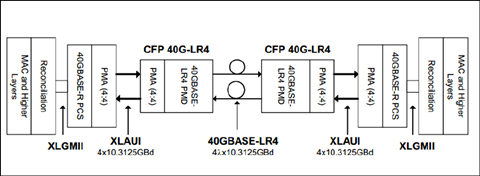
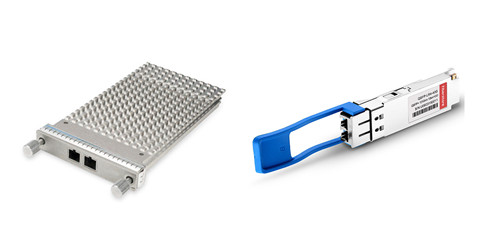
CFP-40G-LR4, similar with QSFP-40G-LR4, is compatible with IEEE 40GBASE-LR4 standard and operates link length of up to 10km over standard single-mode fiber(OS2). However, CFP-40G-LR4 uses SC duplex connectors with a larger form factor, while QSFP-40G-LR4 utilizes LC duplex connector with a compact footprint ( as shown in the above image).
CFP-100G-LR4
100G CFP modules use 10 x 10 Gbit/s lanes in each direction (RX, TX), the optical connection can support both 10 x 10 Gbit/s and 4 x 25 Gbit/s variants of 100 Gbit/s interconnects (typically referred to 100GBASE-SR10 in 100 m reach respectively and 100GBASE-LR4 in 10 km reach.)
Cisco 100GBASE-LR4 CFP is the 100G CFP type that was designed for long-reach 100GbE applications. CFP-100G-LR4 supports a link length of 10 km on standard SMF with duplex SC connectors. It is running at four optical wavelengths (1295.56 nm, 1300.05 nm, 1304.59 nm, 1309.14 nm) and muxing/demuxing of these wavelengths happening inside CFP module.
Comparison Between CFP-40G-LR4 and CFP-100G-LR4
CFP-40G-LR4 and CFP-100G-LR4 share many points in common, such as the wavelength, fiber type, max distance, fiber optic connector and DOM support. Nevertheless, CFP-40G-LR4 is used in 40GbE network, and CFP-100G-LR4 is in 100GbE.

To further understand the difference between CFP-40G-LR4 and CFP-100G-LR4, let’s have a look at the CFP architecture. According to the below image, the whole CFP diagram is composed of two parts—equipment Line card ASC or FPGA, line card interface and optical line interface. There are several "M-Lines†with 10Gbps speed between equipment line card and electrical interface.
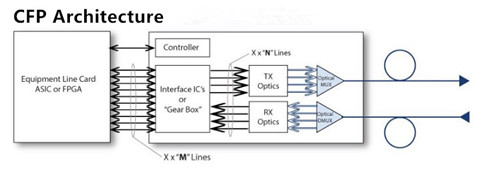
If CFP is working 100GBase-LR4 mode, then it has 10 x 10Gbps M-Lines. As to 40GBase-LR4, it uses 4 x 10Gbps M-Lines. The "gear box†in the image is electrical 10:4 mux/demux module aggregating up to 10 M-Line interfaces in maximum 4 N-Line interfaces. Each N-Line is 25Gbps for 100GBase-LR4 and 10Gbps for 40GBase-LR4. So you may clearly understand the difference between CFP-40G-LR4 and CFP-100G-LR4.
Conclusion
The CFP MSA transceiver module defines hot-pluggable optical transceiver form factors to enable 40GbE and 100GbE applications. CFP-40G-LR4 and CFP-100G-LR4 are the CFP LR4 optics that are compatible with 40GBASE-LR4 and 100GBASE-LR4 standards. Other than the CFP form factor modules, pluggable CFP, CFP2 and CFP4 transceivers support the ultra-high bandwidth requirements of data communications and telecommunication networks that form the backbone of the internet. FS.COM offers a whole sale of CFP/CFP2/CFP4 optical transceivers that available in several standards. Please feel free to contact us if you need anything.
Posted by: fernxu123 at
03:13 AM
| Comments (4)
| Add Comment
Post contains 575 words, total size 6 kb.
April 21, 2017
100G QSFP28 and CFP optical transceivers as the main transmission media of 100G network, dominate 100G hardware market. CPAK, launched right after CFP2 100G modules, is the Cisco proprietary form factor. Since its certification, CPAk was considered as the alternative of CFP form factor modules. Today's article will describe CPAK 100G module in detail and compare it with other 100G modules such as CFP, CFP2, CFP4 and QSFP28 modules.
Designed as a smaller, low-cost alternative to CFP transceiver, CPAK 100GBASE optical module is not popular on the 100G market nowadays. CPAK module is also the first 100G optical transceiver that uses CMOS Photonics technology. This type of 100GBASE module can work in the following Cisco networking equipment—ASR 9000 Series Router; CRS-X Carrier Routing System; NCS 2000, 4000, and 6000 Series Routers; the Nexus 7000 and 7700 Series Switches, and the Cisco ONS Transport Platform.
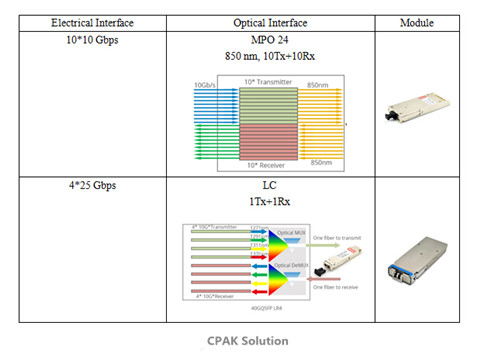
CPAK optical transceiver incorporates IEEE standard interfaces available in several different standards: 100GBASE-SR10, 100GBASE-ER4L, 100GBASE-LR4, 10x10G-ERL, 10x10GBASE-LR, etc. CPAK transceivers can support 10X10Gbps and 4X25Gbps mode for an aggregate of 100Gbps data rate (seen in the above image). It can operate high-density 10G breakout with MPO-24 cables, CPAK-100G-SR10 is operating in this type, which is also backward compatible with 10GBASE-SR. CPAK LR4 module is compatible with other 100GBASE-LR4 compliant modules such as CFP to support high-bandwidth 100Gb optical links over standard single-mode fiber terminated with SC connectors.
The main features of CPAK modules are backward compatibility, smaller form factor and energy efficiency.
As noted before, CPAK was released right after CFP modules. Although CFP is the pioneer in 100G optics, but its big size can not meet the demands of high-density data center. Therefore, CFP2 and CFP4 with more compact sizes are developed. When comparing CPAK with CFP modules, CPAK transceivers are less than one third the size of CFP modules, and dissipate less than one third the power. In a comparison with CFP2 modules, CPAK optical transceivers are 20% smaller and consume 40% less power. In other word, if you use CPAK other than CFP2 modules in your data center switches, it can offer 20% greater port density and front-panel bandwidth.
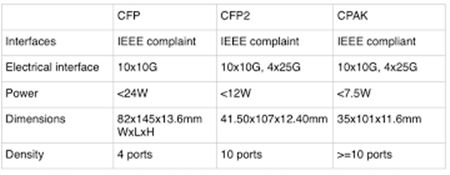
In short, CPAK optical module has smaller footprint than CXP, CFP and CFP2, but bigger than CFP4 and QSFP28 optics. Besides, CPAK 100GBASE-LR4 consumes less than 5.5W, which is less than CFP LR4 (24W), CFP2 LR4 (12W), CFP4 (9W) and CXP LR4 optics (6W) but a little higher than QSFP28 (3.5W). CPAK represents a significant advancement in optical networking, providing dramatic space and power efficiency.
QSFP28 optical transceiver, due to its smallest form factor and lowest power consumption, is regarded as the most promising 100G optical module. In terms of the form factor, QSFP28 is more compact then CPAk modules. As to the power consumption, Cisco CPAK 100GBASE-LR4 module supports link lengths of up to 10 km over standard single-mode fiber with SC connector with a nominal power consumption of less than 5.5W. QSFP28 100GBASE-LR4 supports up to 10km and consumes nearly 3.5W.
QSFP28 transceiver is designed for 100G speeds and using the 4×25 wiring specification. 100G QSFP28 SR4 is designed for short-haul transmission and QSFP28 LR4 is designed for long-haul transmission.
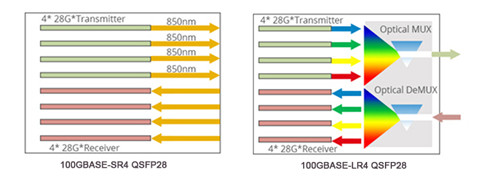
In 2017, 100G technology and relevant optical transceivers gradually become matured. 100G optics like CXP, CFP/CFP2/CFP4, 100G QSFP28 in different standards offers a huge selection for customers. CPAK module was launched just days after the certification of CFP2 optics. It is popular for the smaller footprint and energy economy. However, when competing with open source MSA compatible 100G products (CFP/CFP2/CFP4 and QSFP2![]() , CPAK is not the ideal one for 100G high-density connectivity. However, many third party optical solution vendors like FS.COM announce to help market to cut down this pricing and save budgets for customers. FS.COM will release this cable in the near future, if you are interested, please contact us.
, CPAK is not the ideal one for 100G high-density connectivity. However, many third party optical solution vendors like FS.COM announce to help market to cut down this pricing and save budgets for customers. FS.COM will release this cable in the near future, if you are interested, please contact us.
Posted by: fernxu123 at
08:04 AM
| Comments (1)
| Add Comment
Post contains 660 words, total size 6 kb.
April 07, 2017
Cisco SFP module, compatible with 1000BASE Gigabit Ethernet standard is a hot-swappable input/output device that can plug into a Gigabit Ethernet slot of Cisco switches and routers. Cisco, as a telecom giant supplies a whole series of fiber optic transceiver modules available in 1000BASE-T, 10/100/1000BASE-T, 1000BASE-SX, 1000BASE-LX, 1000BASE-EX, 1000BASE-ZX standards. It is truly dizzying to choose from a whole array of Cisco SFP transceivers, and each often has only minor differences between them. Thus, to help customers choose the suitable Cisco SFP modules, this article will clearly introduce several Cisco GLC modules.
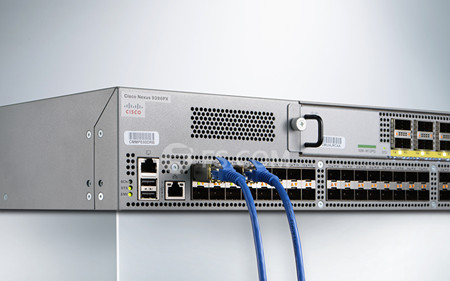
Figure 1 shows Cisco SFP plugging into the Cisco Nexus 9396 switches.
GLC-T
GLC-T is 1000BASE-T Cisco SFP copper 1g module, compliant to IEEE 802.3, operates over Cat5 copper wire for a distance of 100m. Cisco GLC-T fiber transceivers provide 1Gbps data transfer for full duplex Gigabit Ethernet connectivity.
GLC-TE
Similar with GLC-T SFP modules, GLC-TE provides a link length of 100m over Cat5 copper wires. The only difference between these two SFP modules lies in the operating temperature range. GLC-T SFP is commercial temperature range (COM) from 0 to 70°C (32 to 158°F), while GLC-TE is Extended temperature range (EXT) from -5 to 85°C (23 to 185°F).
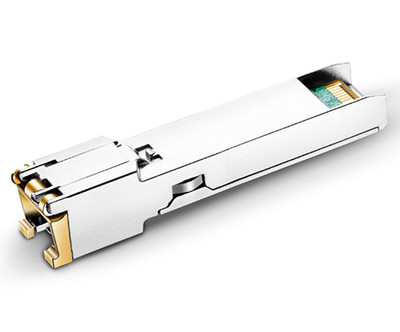
Figure 2 displays GLC-TE SFP module with RJ45 connector.
GLC-SX-MMD
GLC-SX-MMD resembles with GLC-SX-MM module. Both are the Cisco 1000BASE-SX SFP modules operating at the wavelength of 850nm. When connecting with OM2 multimode fibers, this optical transceivers can support up to 550m. However, GLC-SX-MMD allows data rate of 1000Mbps with digital optical monitoring (DOM) support, which performs transceiver monitoring and troubleshooting operation.
SFP-GE-S
SFP-GE-S is compliant with 1000BASE-SX standard. It operates over multimode fibers with a wavelength of 850nm at 550m. Unlike GLC-SX-MM, SFP-GE-S support DOM performance and extended operating temperature range.
GLC-LH-SMD
Compliant with 1000BASE-LX/LH standard, Cisco GLC-LH-SMD can support a large longer distance of 10km. The letter "D†also refers to the DOM support. It operates at longer wavelength of 1310nm over duplex LC single-mode fibers.
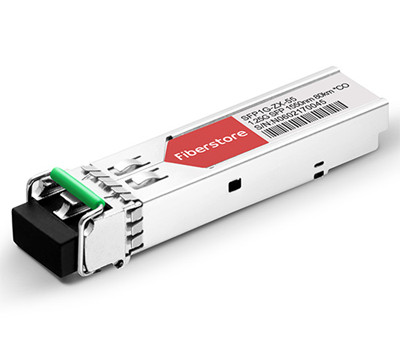
Figure 3 presents GLC-LH-SMD with LC connectors.
GLC-LH-SM-20
Cisco GLC-LH-SM-20 is the advanced version of GLC-LH-SMD, which operate at 1310nm wavelength through LC connector with a transmitting distance of up to 20km.
GLC-EX-SMD
GLC-EX-SMD is the Cisco 1.25Gbps SFP module that is compliant with 1000BASE-EX standard. It operates over 1310nm for distance up to 40km.
GLC-EX-SM1550-40
Compatible with 1000BASE-EX Gigabit Ethernet standard, this Cisco SFP also support a link length of 40km with DOM support. But unlike GLC-EX-SMD operating at 1310nm, this optical transceiver module works over 1550nm wavelength.
GLC-ZX-SM
As the name implies, Cisco GLC-ZX-SM is compliant with 1000BASE-ZX standard for single-mode fibers. When used in Cisco 2960 switch, it can support a link length of up to 70km at 1550nm.
GLC-EZX-SM-100
If the GLC-ZX-SM with a distance of 70km can not meet your network requirement, then you can use the GLC-EZX-SM-100 modules for 100km.
GLC-EZX-SM-120
GLC-EZX-SM-120 with a operating wavelength of 1550nm can reach up to 120km over single-mode fibers.
Conclusion
This article lists several Cisco SFPs with detailed specification, such as the media type, supporting distance, wavelength, operating temperature range, etc. If you have Cisco switches and don’t know how to choose the suitable SFPs, you can have a look through this article or directly visit www.fs.com.
Posted by: fernxu123 at
09:57 AM
| No Comments
| Add Comment
Post contains 545 words, total size 6 kb.
35 queries taking 0.1042 seconds, 86 records returned.
Powered by Minx 1.1.6c-pink.









